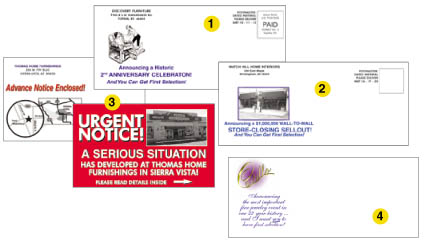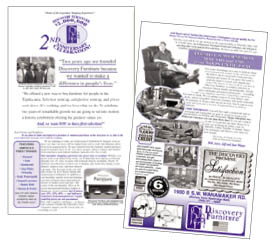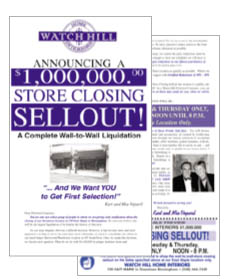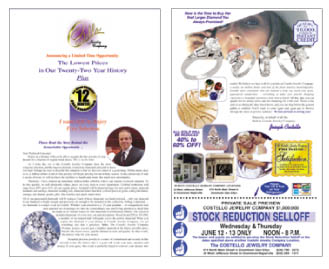Many merchants make the mistake of assuming that if they keep the message short, customers will read it. This is just not true.

Setting The Stage: The Envelope
1. An Anniversary Celebration for a very unique store. Discovery Furniture never uses the "S" word, and this event was quite a challenge. See the letter pictured below.
2. This closing event in a Detroit suburb was a challenge because of the small space (8500 square feet) and very expensive media. See the exhibit on page 38.
3. A self-mailer with a more promotional approach. This event was run after the sale had been going on for several weeks. The result was a tremendously successful wind-up after a great deal of business had already been done.
4. The envelope of a fine jeweler who needed to reduce inventory, but did not want to damage his upscale image. This low key, full color approach was originally developed for a jeweler, but it works quite effectively for middle to high end furniture stores. See the exhibit below.
If someone tells you Direct Mail is your number one opportunity to increase sales and profits, listen carefully. A "How To" list is important. However, don’t forget that the creativity that goes into a mailing is the most important ingredient of all. Whose creativity? What kind of creativity?
YOUR MERCHANDISING CREATIVITY
My very first on-site sale as an independent consultant took place many years ago in a tiny store in Tulsa, Oklahoma. When asked if they had a mailing list, the owners of this "mom and pop" store who were conducting a GOB retirement sale, said "Sure." Since we had a miniscule budget, buying a large list was out of the question. So, after a careful interview of the owners, a private sales invitation letter was written, carefully hand addressed and mailed to their list of 350. On the private sale night the store was filled with customers and nearly forty thousand dollars in business was generated, by far the largest day in their history. In the words of David Ogilvy: “I had tasted blood.”
Direct mail is still a valuable secret tool in generating cost-effective sales and profits. These days, storeowners almost always have a mailing list, but these are frequently out of date. Yet, at least there is hope, a personal mailing list can be developed from historical customer data. Purchased lists can also be very helpful in cultivating a bigger market share. However, there can be no question that a list generated from people who have been in your store and bought merchandise is pure gold, and nothing can be more valuable for a retailer.
The greatest creative idea in the world will fail if it does not reach the right people. That is why maintaining an up to date mailing list is so important. Now, once you have a good list in place, what next?
THE BLANK PAGE AND THE CREATIVE IDEA
This is the moment of truth. Imagine you have managed to get your piece to the right prospect, got them to open the envelope (more about that later), and it is time for them to decide whether to read your message or not. Many merchants make the mistake of assuming that if they keep the message short, customers will read it. This is just not true. If the message engages them them and keeps them interested, then they will read it.
How difficult is it to engage the prospect? Very difficult. Imagine you are standing on a busy street corner. Prospects are passing by. They are busy, have very little time, and are under great pressure. Imagine that every bit of income you will receive for the next month depends upon your ability to capture their attention. What can you say that will stop them in their tracks? And, even more important, what will be the overall impression you communicate beyond your words? What is the psychological environment you create by your general appearance, your tone, your body language? These and many other factors fused together with your words (in a fraction of a second), to determine whether the prospect will decide whether or not you are worth listening to. Once you pass this barrier - and make no mistake, it’s a big one - you must be able to convince them to listen to your story. (People love stories, they dislike sales pitches.)
Don’t panic. Almost every furniture storeowner can keep customers engaged for hours with stories about furniture. When faced with a blank sheet of paper, however, most of these same owners become "tongue tied." This is the time when the value of a trained professional who can capture your thrilling words and convert them into print becomes apparent. Authentic pros are not easy to find.
Now instead of imagining that you are standing on a busy street corner, lets examine the similar situation you face when you address a customer in print. Everything comes into play. The general appearance of the mailing piece and the name of your store make the first important impression. If you are well branded, your mailing will be welcome. Some experts still advocate mailing a first class letter with a stamp on it and without a return address, declaring it is sure to be opened. Since Anthrax, this is an obsolete idea. There are many options as to the kind of mailing piece to use, but for this example let’s use a letter in a legal envelope.
THE ENVELOPE
In most cases, start with a simple message and some kind of illustration on the front. If you do your job well here, the letter will get opened. In other words, you must make the recipient feel compelled to learn more by opening the letter. Remember the street corner analogy and check the exhibits on page 34.
THE PAPER
It should be obvious that a letter written on cheap bond generally is not going to make a good impression. As far as paper goes, a more important factor to consider, is one that almost no one thinks about. That is the size of the paper. In most cases use a legal size sheet. Why? Because it looks different and more can be done with it. This is not a rule cast in stone, but you can get an idea of the value of using legal sized letters checking out the exhibits on these pages.
THE HEADLINE
As a general rule, letters must have a headline. And that headline had better enlarge upon the promise made on the outside of the envelope, and fulfill the expectations of the curious prospect. At this point, in the marketing to this generation of consumers, the most effective letters don’t look much like letters. They are more like small brochures with illustrations, in full color if possible (and appropriate). Assuming that your envelope, paper and headline have stopped the prospect in her tracks and made her curious for more, how do you carry the story along?
THE STORY
In the body of the letter we pick up the thread of the story once more. Don’t change the subject. Begin to enlarge upon the story line. Here is a key point. A prospect should be able to grasp the essentials of your story by simply looking over the letter, and being able to do so in five seconds or so. The essentials of your story are the same as journalism 101: WHO-WHAT-WHEN-WHERE-HOW and WHY? If the idea of conveying all of this in seconds is hard to grasp, look over the exhibits in this article and they will help you understand how to graphically express these ideas. This WHO-WHAT-WHEN-WHERE-HOW and WHY? formula is explained in more detail in the April/May issue of FURNITURE WORLD Magazine "How To Buy Print Media For Half-Price" (archived in the Marketing Management Index on www.furninfo.com). Briefly, each of these elements needs to be expounded upon in your story in depth. For example, WHO? Is more than your name and address, it is your unique factors, all the things you can do better than anyone else in the world. It is your brand, which includes specifics such as how long you have been in business, what you stand for, what you guarantee or promise, perhaps your photo, a photo of your store, and on and on. When we write a letter for a client we use a checklist of 83 specifics that address the WHO-WHAT-WHEN-WHERE-HOW and WHY? formula. Brainstorm and see if you can’t think of more. The easiest-to-convince customer who knows you and likes your store is looking for car keys by now so she can drive to your event. But, the tougher customer has not been sold yet. Hopefully, she is intrigued enough to read the letter, but she has not yet been sold. In addition, she does not have enough information as yet to convince her husband (he can think of a lot of objections) to make the trip to your store. So, your story must under-gird the claims, promises and smoke of your presentation with some hard facts. Think of your story as having five phases. This syntax is critical to the construction of every letter you write, and every selling proposition you make. If all this seems like a lot of work, remember there are vastly more prospects in the harder-to-sell category than the easy-to-sell category. And the harder the prospect is to sell, the more there are of them.

Telling The Story In Words & Pictures: Who-What-When-Where-Why?
All these questions are answered graphically in a few seconds. There is more detail for the harder-to-persuade customer. The legal size costs very little more to print than standard, and the impression is much stronger. Of course, this does not look like an ordinary letter, but it's purpose is to communicate and persuade, not to look like an ordinary letter.
THE STORY… ADVANCED COURSE
There is a specific sequence in a selling proposition that must be adhered to. Let’s take financing for example. You would never greet a customer with: "Hello, we have Zero percent financing this week," yet, it is common to see furniture stores lead with this information in ads. In a selling sequence, first you must build rapport with customers and probe to discover their needs. To persuade the hardest to convince customer in a printed piece requires five precisely defined steps.
Step One: The Irresistible Promise to Fill a Need. First off, you must very quickly arrest the mind of the prospect and convince her that you have something to offer that she wants and needs. If the envelope, general appearance of the piece and headline have done their jobs, this has been accomplished, and now she is into the body of the letter.
Step Two: You Have the Perfect Solution to Fill Her Need. Quickly, you must convey the basic benefits of your proposition from the point of view of the consumer. She could not care less that you are overstocked. However, she may be very interested that you have a fabulous, factory-fresh selection of the latest styles and finishes and you are going to offer them at a big discount relative to their retail value. Then, she may be persuaded that you can make this offer because you are overstocked and need to clear the decks. Just be sure the story is totally true.
Step 3: What You Have to Offer is Worth Much More than You are Asking Her to Pay. You achieve this level of persuasion by enhancing the value of the merchandise, not by talking about how low-priced it is. Brand names are very significant. But also talk about the latest styles, and how your buyers search the market for the perfect items for your area. Talk about how carefully you individually hand-select merchandise that will provide the maximum in beauty and long lasting service. Use specific numbers and hard statistics with reasonable frequency, such as "we have over 80 recliner styles on display" or "browse through our three million dollar selection." Embellish the quality and value of your selection and your specific offerings to make your bargains sound even better. Don’t beat low price to death, talk about high value.
Step 4: Here is Proof that Everything I Told You is True. Proof is, of course, partially established throughout the story by a sprinkling of specifics such as brand names. The final effort at proof is subjective to the offer. When we reach this point in our presentation, I often use a phrase such as: "Here is what you will see when you visit us on (day and date)," and then go on to give a short word picture of the glorious array of wanted merchandise that will be clearly tagged with fabulous discounts. The only catch is, it better look that way when the customer comes in. They better be greeted by someone instantly and their letter taken seriously. Having created big expectations, your job is now to exceed them. Mentioning years in business, carefully phrased, is persuasive at this point. Casually mentioning an award can be very strong. (Curtis Bros., many years ago, continually pounded away this phrase: "Washington’s only Brand Name Award-Winning Furniture Store.)." Don’t be shy, just toot your horn tastefully.

How To Fill Up A Store For Three days With Preferred Customers
On the first day this store owner made the error of letting someone in at nine a.m. and was over-run in a few minutes. The preferred customer sale did two months business in the three days this event ran, and the regular sale took off with tremendous momentum.
Step 5: Buy now, don’t wait. So many merchants succeed in all the steps and then fail to make the close, the call to action. You must make it clear that it is now or never for this historic offer. Summarize your offer of "the lowest prices of the year PLUS 12 months free financing" or whatever. Remind them they get to pre-shop. Tell them you will be closed to the general public (if this is true) and not to be confused by your newspaper ads and radio that say the sale to the general public begins the next day. Remember action is triggered by scarcity—either scarcity in time or scarcity in product availability. And, by the way, very successful private sales have been created under specific circumstances that give as many as three days of private shopping. The number of days is a judgment call based upon the size of the list, the nature of the event, and other variables.
This is a bare bones outline of everything you need to know about making your direct mail effective. Just remember, you are creative, everyone is. You may not be genetically engineered to write or make graphics. However, if you can provide the creative merchandising dynamics, with the information provided here you have the touchstones by which to evaluate the final product of your writers and graphics people. Unfortunately, they are rarely adequately trained to convert your merchandising dynamics into persuasive and effective selling propositions without a great deal of strong leadership and guidance.

How To Dazzle A High End Customer
How does a better store achieve a flood of cash flow and reduce inventory without disturbing its image? It's all in the way you say things, and the way you look when you say them. A fine jewelry store is as sensitive about image as you can get. By using a full color presentation, an upbeat, fashion image is presented, and yet customers are told the story in a straightforward way. Styles and theory can be endlessly debated, but the final proof is: did it work? did it achieve the goal?
Larry Mullins, President of UltraSales, Inc., has 30+ years experience in the front lines of retail furniture marketing. Larry's mainstream executive experience, his creative work for "promoter-specialists," and study of advertising principles has enabled him to continually develop new High-Impact strategies for independent furniture retailers that are sound, complete, and innovative. Inquiries can be sent to Larry care of FURNITURE WORLD at editor@furninfo.com.